Basic Medical Terminology Tutorial and Exam Guidelines
Explore the basics of medical terminology, study materials, testing procedures, and course objectives. Understand the importance of Latin and Greek terminology in medicine, testing protocols, credit test information, attendance requirements, and course outcomes. Enhance your knowledge and skills in creating and understanding medical terms, mastering vocabulary systematically, and recognizing anatomical structures. Stay updated on exam schedules, resits, and accessing test results.
Download Presentation

Please find below an Image/Link to download the presentation.
The content on the website is provided AS IS for your information and personal use only. It may not be sold, licensed, or shared on other websites without obtaining consent from the author.If you encounter any issues during the download, it is possible that the publisher has removed the file from their server.
You are allowed to download the files provided on this website for personal or commercial use, subject to the condition that they are used lawfully. All files are the property of their respective owners.
The content on the website is provided AS IS for your information and personal use only. It may not be sold, licensed, or shared on other websites without obtaining consent from the author.
E N D
Presentation Transcript
Tutorial in Basic Medical Terminology
Study materials Teachers own materials (e.g. hand-outs, presentations, activity cards) which are going to be periodically uploaded on the IS in Study materials of your subject. Prucklov , R. Severov , M.: Introduction to Latin and Greek Terminology in Medicine. Praha: KLP, 2012 (Unit 1-7) "Drill" on the IS (https://is.muni.cz/auth/dril/?lang=en )
Testing Vocabulary tests at the beginning of each lesson Two partial exams each successfully written partial test (over 70 %) means that you get bonus 5 % for your final exam) Credit test 70% required if you were not successful in any of the partial tests 65% required if you were successful in ONE of the partial tests 60% required if you were successful in BOTH partial tests
Testing Students can sit the credit test in the 15thweek (May 29-June 4, 2017), there are no exceptions to this whatsoever. Resits of the credit test will take place only during the exam period, i.e. June 5 July 9, 2017, or during the extended exam period, i.e. August 28 September 10, 2017. The number of possible credit test resits is two. The dates and number of resits set by the teacher before the exam period is final, it means no other dates will be added during the exam period or later.
Testing Results of the tests will be available to students in the Notebook on the IS. The student s results will be given in percentage together with the pass mark. The student will have the access to his/her tests during guarantee s office hours only.
Attendance Absences are going to be electronically registered in the IS. In order to be sure you have been registered as present in the class, be punctual, the attendance is always checked immediately after the beginning of the class. We can tolerate TWO unexcused absences only; all further absences have to be properly excused by the Study Department. Unexcused absences are regularly recorded in the Notebook on the IS, and students having these records cannot sit the credit test.
Course objectives The course will focus on basic latin grammar to help the studensts understand medical terminology After passing final exam, the students will: understand rules of creating Latin terms and to understand meaning of particular terms create correct Latin terms (both from anatomical and clinical terminology) master the vocabulary in a systematic way understand the system in the terminology of anatomical structures ( = easier memorizing of the terms)
Vowels A B C D E F G H I K L M N O P Q R S T U V X Y Y Z Diphtongs Vowels Long (father) fr ct ra (sad) art ria (intrigue) sp na Short A (cut) lingua E (met) vertebra I (intrigue) digitus I (yes) > J AE= (care) anaemia OE= (care) lagoena Greek words OE (o-e) dyspnoe EU (e-u) euthanasia (door) sens rius O (on) skeleton (boom) rupt ra Y (analysis) hypophysis Y (lady) tympanum U (put) uterus
Read aloud ossa diploe cubitus venae diameter sacralis ulcus iris sutura sigmoideus depressor area oesophagus melior meatus leucocytus hypnosis ala olla eupnoe ileus mucus haematoma iliacus
Consonants A B C D E F G H I K L M N O P Q R S T U V X Y Z Pronunciation Consonant/group of consonants 1: c + a, o, u, consonants Example [k] medical camera, costa, cultivatio, cranium caecus, coeliacia, centrum, circulatio, cynismus chirurgia, cholera c + ae, oe, e, i, y [ts] tsar 2: ch [x] loch
Consonants II Pronunciation Consonant/group of consonants 3: g gu + vowel Example [g] ground [gv] gramma, gastritis lingua, sanguis 4: h 5: j + vowel [h] house [y] yes herba, haematologia iniectio/injectio, maior/major pneumonia, pulmo phantasia, pharmacia aqua, quadriceps vertebra, ruptura rheuma, rhinitis 6: p [p] present [f] physiology [kv] [r] rupture [r] p + h 7: qu+ vowel 8: r r+h
Read aloud lingua, unguis, diameter obliqua, liquor cerebrospinalis, lobus quadratus hepatis os nasale, medulla ossium, dorsum, ossa cranii, intestinum crassum, junctura fibrosa, membrana interossea antebrachii, musculus masseter, musculus risorius aorta descendens, arteria comitans nervi ischiadici, articulatio sacrococcygea, intestinum caecum, tunica mucosa vesicae urinariae, fossa sacci lacrimalis, pectus, occiput phalanx media, diaphragma, diaphysis, encephalon, os sphenoidale, hemispherium, kyphosis, sphincter, nephros, symphysis pubica antebrachium, facies, atrium cordis dextrum, brachium sinistrum, endometrium, frenulum labii inferioris, impressio cardiaca, os hyoideum, promontorium tonsillae palatinae, areae gastricae, arteria nutricia ulnae, cartilago tubae auditivae, meatus nasopharyngeus, membrana vitrea, musculus tensor fasciae latae, plicae palatinae transversae, sulcus glutealis, tunica mucosa tracheae
What will you find in the dictionary? English words are presented in one single form !!!Latin words are presented in three forms!!! E.g.: MUSCULUS, I, M. = MUSCLE English translation Genitive ending/or even full Genitive form Gender abbreviation Main form (full nominative) OS, OSSIS, N. = BONE !CAUTION! ALL THREE FORMS are EQUALLY important for the future ability to use the noun in the context.
Gender ENGLISH has 3 genders: HE refers to male humans and animals SHE refers to female humans and animals IT inanimate objects or animals LATIN has 3 genders: not only humans and animals, but also other objects are thought of as being: masculine -> discipulus (he-student), musculus (muscle) feminine -> discipula (she-student), vena (vein) neutral -> corpus (body) THERE IS NOTHING, WHICH COULD INDICATE THE GENDER TO YOU YOU HAVE TO LEARN IT BY HEART In Latin, adjectives change their form depending on the noun to which they refer Without knowing noun s gender you CANNOT attach a correct form of an adjective to it.
Genitive ending => Declension Declensions are groups of nouns (or adjectives) using the same set of suffixes (=endings) There are 5 declensions in Latin Genitive ending is the only part of the word, which will indicate you its declension
Decide on the number of declension 0. corpus, oris, n. cutis, is, f. 1. caput, itis, n. 2. capilli, orum, m. 3. facies, ei, f. 4. os, oris, n. lingua, ae, f. 3 3 3 2 5 3 1 13.,18. digitus, i, m. 2 27. hypogastrium, ii, n. 29. truncus, i, m. 30. manus, us, f. 31. crus, cruris, n. 32. tarsus, i, m. talus, i, m. 33. pes, pedis, m. 34. hallux, ucis, m. 2 2 4 3 2 2 3 3 14. sulcus, i, m. 15.,28. penis, is m. 16. femur, oris, n. 17. genu, us, n. 19. frons, frontis, f. 2 3 3 4 3 5. mentum, i, n. 6. axilla, ae, f. 7. brachium, ii, n. 8. cubitus, i, m. 9. antebrachium, ii, n. 2 1 2 2 2 20. oculus, i, m. 21. nasus, i, m. 22. auris, is, f. 23. bucca, ae, f. 24. collum, i, n. cervix, icis, f. 25. pectus, oris, n. 26. abdomen, inis, n. 2 2 3 1 2 3 3 3 10. carpus, i, m. 11. pollex, icis, m. 12. palma, ae, f. 2 3 1
Genitive ending stem of a word A stem is a form to which endings can be attached In some declensions (1st, 4th, 5th, and in majority of cases also 2nd) the nominative and genitive forms of the word have identical stem In some declensions (3rd, partially 2nd) word s stem can greatly different WE NEED TO REMOVE THE GENITIVE ENDING IN ORDER TO GAIN THE GENITIVE STEM dol-or dolor-is corp-us corpor-is de-ns dent-is ven-a ven-ae humer-us humer-i arc-us arc-us faci-es faci-ei diamet-er diametr-i gen-u gen-us
Decide what is the stem of the noun ex: caput, capit-is skeleton, skeleti os, ossis cranium, cranii orbita, orbitae collum, colli cervix, cervicis thorax, thoracis costa, costae discus, disci processus, processus vertebra, vertebrae pelvis, pelvis coxa, coxae ilia, ilium coccyx, coccygis ischium, ischii pubes, pubis symphysis, symphysis nasus, nasi dens, dentis mandibula, mandibulae clavicula, claviculae scapula, scapulae sternum, sterni humerus, humeri arcus, arcus radius, radii ulna, ulnae metacarpus, metacarpi carpus, carpi phalanx, phalangis femur, femoris patella, patellae tibia, tibiae fibula, fibulae metatarsus, metatarsi
Latin inflectional language In many languages, Latin and Greek among them, nouns inflect (change their form) for number and for case. Inflection for number involves singular (sg.) : plural (pl.) forms (eg. forearm : forearms, antebrachium : antebrachia) and is present in English as well. Inflection for case involves changing the form of the noun according to its syntactic function/meaning. Latin has extensive case system in which a special form is used for every specific meaning. In medical terminology we use 4 out of 6 Latin cases to express the following meanings:
Cases and their meanings LATIN system of specific case endings + prepositions ENGLISH prepositions or word order 1. NOMINATIVE subject (ending) subject of the sentence 2. GENITIVE dependency of two nouns, possession (ending) of 4. ACCUSATIVE object, movement (preposition + ending) object of the sentence 6. ABLATIVE place, location, instrument, cause (preposition + ending) In medical terminology ACCUSATIVEand ABLATIVEcases are used ONLY AFTER the PREPOSITION. NOMINATIVE and GENITIVE NEVER appear AFTER a PREPOSITION by, with, to, because of...
ONLY ACCUSATIVE (4TH CASE) AND ABLATIVE (6TH CASE)APPEAR AFTER A PREPOSITION
Introduction to syntax NOUN IN APPOSITION I. noun + noun < GENITIVE Translated: Meaning: using of state of dependency, possession EX: Fractura costae //fractura costarum Fracture of rib ! = rib fracture = rib fractures Fracture of ribs
Connect two nouns ex: caput + costa > caput costae head of rib caput femoris caput + femur -> caput fibulae caput + fibula -> caput humeri caput + humerus -> caput phalangis caput + phalanx -> caput radii caput + radius -> caput tali caput + talus -> caput ulnae caput + ulna ->
Adjectives of the 1stand 2nddeclension, dictionary entry Magnus, a, um Magnus magna magnum m. Dexter, a, um Dexter dextra dextrum m. f. n. f. n. coxa oculus crus bucca fibula cervix sulcus arcus metatarsus hallux coxa oculus crus bucca fibula cervix sulcus arcus metatarsus hallux
Find all the adjectives vena, ae, f. periculum, i, n. fractura, ae, f. suspicio, onis, f. thorax, cis, m. fractus, a, um dies, ei, m. pulsus, us, m. hepaticus, a, um arcus, us, m. thoracicus, a, um hepar, tis, n. rete, is, n. planus, a, um caesareus, a, um diameter, tri, f. caries, ei, f. ruptus, a, um flexor, oris, m. bonus, a, um
Find all the adjectives vena, ae, f. periculum, i, n. fractura, ae, f. suspicio, onis, f. thorax, cis, m. fractus, a, um dies, ei, m. pulsus, us, m. hepaticus, a, um arcus, us, m. thoracicus, a, um hepar, tis, n. rete, is, n. planus, a, um caesareus, a, um diameter, tri, f. caries, ei, f. ruptus, a, um flexor, oris, m. bonus, a, um
Agreed-attribute What is the correct adjective for the noun in the triangle? dextra dextrum dexter dextrum genu orbita pes dexter dextrum dextra dexter dextra
Structure of multi-word medical terms two-word terms: noun + adjective in nominative singular: costa vera (true rib); fibula fracta (broken calf-bone) noun in nominative + noun in genitive (second noun is usually translated into english using of ) spina scapulae (spine of shoulderblade); fractura fibulae (fracture of calf bone) noun in nominative + noun following a preposition ACC: medicamentum contra dolorem (remedy against pain) ABL: medicamentum pro adultis (remedy for adults) multi-word terms combining these types in various ways status post fracturam colli femoris sinistri cum dislocatione state after a fracture of the neck of the left femur with a dislocation extractio dentis canini propter cariem profundam cum anaesthesia locali extraction of canine tooth because of deep dental decay with local anesthesia
1st Latin declension Example word: v na, ae, f. case singular plural nom. v na v nae gen. v nae v narum ak. v nam v nas abl. v n v nis
1st Greek declension In the first declension we decline nouns that have: Genitive sg. ending Nominative sg. ending Gender -ES -AE -E -ES F M
1st Greek declension systole, es, f diabetes, ae, m. diabetes diabetae diabetam diabeta nom. sg. systole gen. sg. ak. sg. abl. sg. systoles systolen systole o All nouns infleced like systole, es, f.are of feminine gender. o All nouns inflectted like diabetes, ae, m.are of masculine gender. o Paradigms vena, systole and diabetes have identical endings in plural.
Feminine form of adjectives ending in US, A, UM / ER, A, UM
Homework learn 1st declension by heart revise/learn terms for grammatical categories revise/learn vocabulary from handouts 1.1, 2 and 3 revise prepositions see pdf file PREPOSITIONS translate into Latin following slide:
Translate complicated fracture of right shinbone rupture of coronary artery congenital anomaly of vertebral column (literally: column of vertebrae) after angina cause of acute dyspnea mucous membrane of gall bladder fracture of the fourth coccygeal vertebra congenital insufficiency of eustachian tube treatment of chronic allergy























